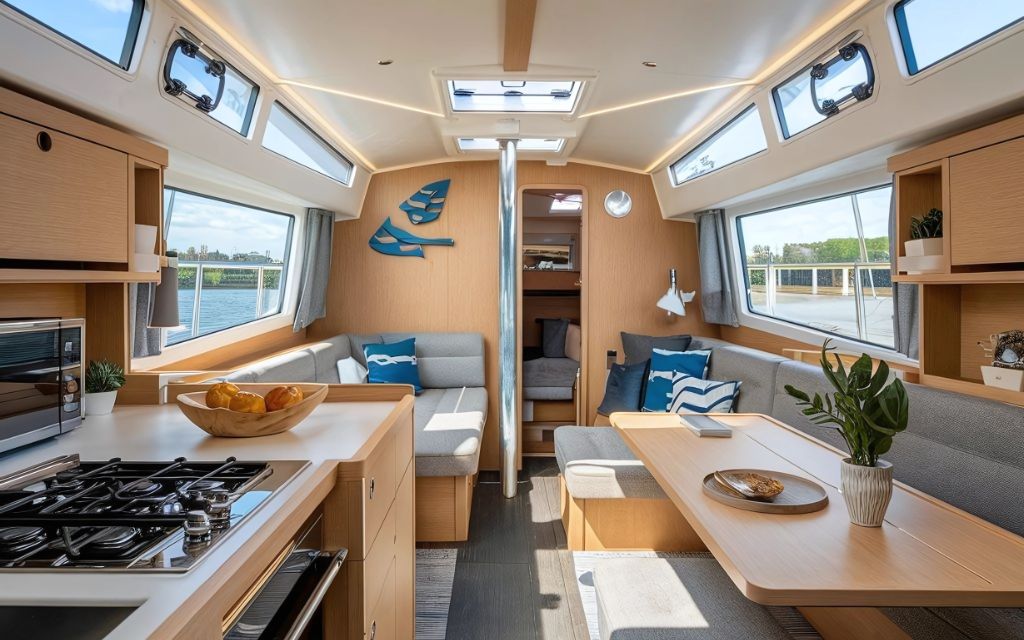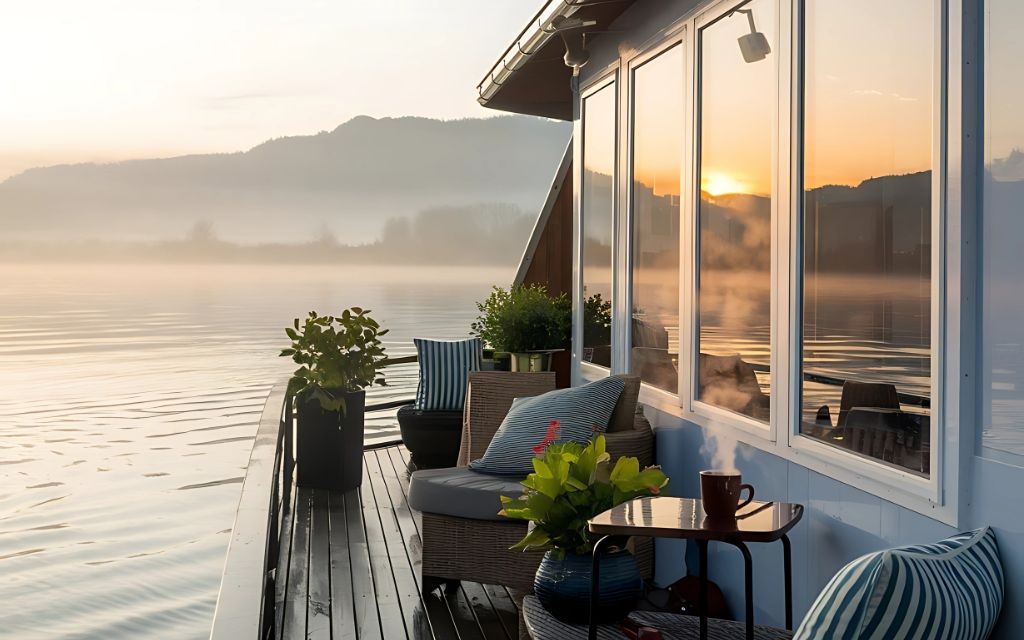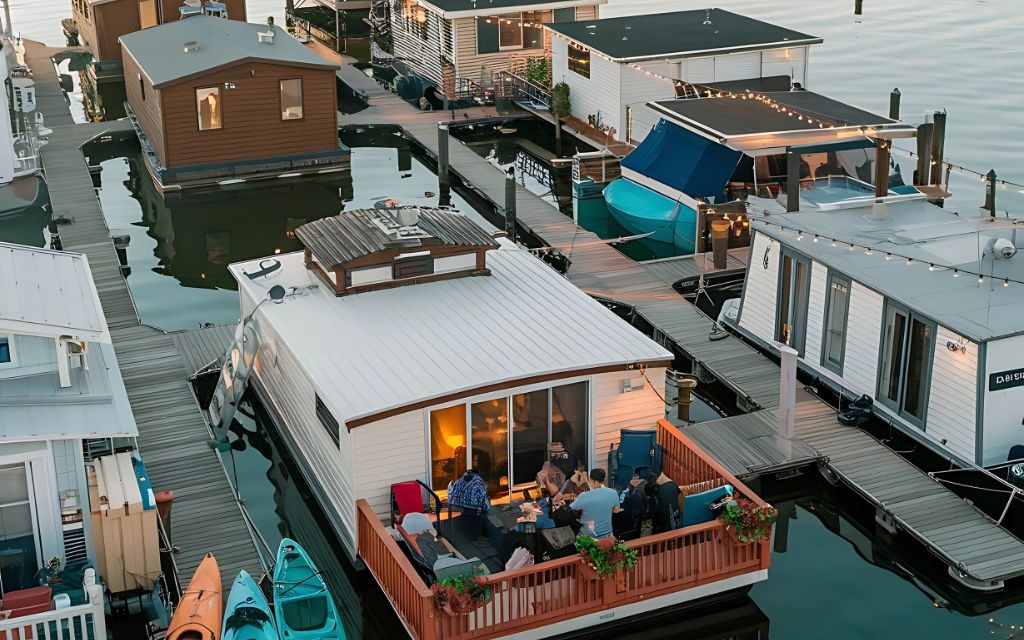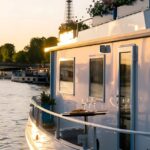Table of Contents
Day-to-day life on a houseboat represents a unique lifestyle choice that combines the comfort of home with the adventure of waterfront living.
As someone who has experienced the joys and challenges of houseboat life firsthand, I’m excited to share an authentic glimpse into this fascinating way of living.
Introduction to Day-to-Day Life on a Houseboat
The concept of houseboat living has evolved significantly over the years, transforming from a purely practical solution for waterway workers to a lifestyle choice embraced by people seeking an alternative to traditional housing. Today’s houseboats range from cozy floating homes to luxurious vessels equipped with modern amenities.

Types of Houseboats and Their Features
| Houseboat Type | Primary Features | Best Suited For |
|---|---|---|
| Static Houseboats | Permanent mooring, full utilities, spacious living areas | Year-round residents |
| Cruising Houseboats | Mobile, engine-powered, varying sizes | Adventure seekers |
| Floating Homes | Stationary, connected to shore utilities | Those wanting traditional home amenities |
Morning Routine on a Houseboat
Starting your day on a houseboat brings a unique set of experiences that traditional homeowners might never encounter. The gentle rocking motion and the sound of lapping water create a peaceful awakening that’s hard to replicate elsewhere.
Essential Morning Tasks in Houseboat Living:
- Check weather conditions and water levels
- Inspect mooring lines and bumpers
- Monitor battery levels and water tanks
- ventilate living spaces
- Clean solar panels if installed
Daily Activities and Houseboat Maintenance
Houseboat maintenance requires consistent attention to ensure everything runs smoothly. The houseboat lifestyle demands a proactive approach to caring for both the interior and exterior of your floating home.
Regular Maintenance Schedule
| Task | Frequency | Importance |
|---|---|---|
| Hull Inspection | Monthly | Critical |
| Plumbing Check | Weekly | High |
| Engine Service | Quarterly | Essential |
| Solar System Review | Monthly | Important |
| Battery Testing | Weekly | Crucial |
Living Spaces and Amenities
The interior design of houseboats requires creative solutions for maximizing space. Houseboat furniture needs to be both functional and secure, while houseboat kitchens often incorporate space-saving features that would benefit any small living space.
Space-Saving Tips for Houseboat Living:
- Install fold-down tables and murphy beds
- Utilize vertical storage solutions
- Choose multi-purpose furniture
- Implement creative storage solutions
- Design with mobility in mind
Community Life and Social Aspects
The houseboat community creates a unique social environment where neighbors become like family. Houseboat neighborhoods often foster close-knit relationships through shared experiences and mutual support.
Living in houseboat communities means embracing a lifestyle where collaboration and friendship naturally develop.
Whether it’s helping with docking maneuvers or sharing maintenance tips, the spirit of cooperation defines houseboat living.

Events and Activities
- Seasonal community gatherings
- Shared maintenance days
- Floating farmers markets
- Water-based festivals
- Holiday celebrations
Environmental Considerations
Eco-friendly houseboat living has become increasingly important. Sustainable houseboat living practices include:
- Solar power systems
- Water conservation methods
- Composting facilities
- Natural cleaning products
- Energy-efficient appliances
Practical Challenges and Solutions
Weather-Related Challenges
Houseboat life requires adaptability to weather conditions. Strong winds, storms, and seasonal changes can impact daily routines. Proper houseboat exterior maintenance becomes crucial during extreme weather.
Essential Safety Measures
- Regular safety equipment checks
- Updated emergency protocols
- Weather monitoring systems
- Secure mooring systems
- Fire safety equipment
Technical Aspects
Houseboat Electrical Systems and Utilities
Modern houseboats combine traditional and alternative power sources. Houseboat utilities must be carefully managed, with backup systems for essential services.
Plumbing and Water Management
Houseboat plumbing requires specialized knowledge and regular maintenance. Water conservation becomes second nature in houseboat living.
Financial Considerations
Cost Breakdown for Houseboat Living:
- Mooring fees
- Insurance premiums
- Maintenance costs
- Utility expenses
- Fuel charges
Seasonal Adaptations
Different Seasons Bring Various Challenges:
- Winter: Heating systems and insulation
- Summer: Cooling strategies and sun protection
- Spring: Maintenance and cleaning
- Fall: Storm preparation and winterizing
Tips for Prospective Houseboat Residents
- Research houseboat regulations thoroughly
- Connect with experienced houseboat owners
- Understand maintenance requirements
- Consider location carefully
- Plan for seasonal changes
Conclusion
The houseboat lifestyle offers a unique blend of adventure and comfort. While it presents distinct challenges, the rewards of waterfront living and community connection make it a fulfilling choice for those seeking an alternative lifestyle.
FAQs
What Are The Characteristics Of A Houseboat?
A houseboat combines the elements of both a home and a vessel, featuring unique characteristics that set it apart from traditional dwellings.
These floating homes typically range from 20 to 100 feet in length, with most residential houseboats falling between 40 to 60 feet.
The design often incorporates wide beam construction for stability and maximized living space, while maintaining a relatively shallow draft for navigating various waterways.
The structural composition includes specialized materials designed to withstand constant water exposure and marine conditions.
Modern houseboats feature fiberglass or aluminum hulls, though some older models may have wooden construction.
The superstructure usually consists of lightweight yet durable materials, with careful attention to weight distribution and buoyancy calculations that ensure safe operation and comfortable living conditions.
What Are The Downsides Of A Houseboat?
Living aboard a houseboat presents several challenges that potential owners should carefully consider before making the transition.
The most immediate concern is space limitation, which requires significant downsizing and creative storage solutions. Weather vulnerability also poses a constant challenge, as storms, high winds, and extreme temperatures can directly impact daily life and safety considerations.
Maintenance demands tend to be more intensive and frequent compared to traditional homes, largely due to the constant exposure to moisture and marine elements.
Owners must regularly inspect and maintain hull integrity, mechanical systems, and weather sealing. Additionally, the cost of specialized maintenance, marina fees, and insurance can sometimes exceed traditional housing expenses, while securing financing may prove more challenging due to the unique nature of houseboat ownership.
Why Do People Like Houseboats?
The appeal of houseboat living stems from the unique combination of freedom and connection to nature that it provides.
Many enthusiasts are drawn to the constant proximity to water, which offers both peaceful moments and opportunities for recreational activities right at their doorstep.
The lifestyle attracts those seeking to break free from conventional living arrangements while maintaining modern comforts.
Moreover, houseboat communities often foster strong social bonds, creating a tight-knit environment where neighbors become extended family.
The shared experience of waterfront living creates natural opportunities for socializing, whether through casual dock conversations or organized community events.
This sense of community, coupled with the potential for lower living costs in some regions, makes houseboat living particularly attractive for those seeking an alternative lifestyle.
What Is Inside A Houseboat?
Modern houseboats are equipped with surprisingly comprehensive amenities that mirror traditional homes. The interior typically features a main living area with clever storage solutions and multi-functional furniture, alongside a fully equipped kitchen with compact appliances.
Most designs incorporate one or two bedrooms, though the sleeping arrangements vary based on the vessel’s size and layout.
The bathroom facilities, often called the head, include marine toilets connected to holding tanks, showers, and sinks, all designed to operate efficiently within the space constraints.
Additional features might include built-in entertainment systems, climate control units, and workspace areas.
Many houseboats also boast outdoor living spaces like decks or rooftop lounges, effectively extending the usable space beyond the interior confines.
What Does A Houseboat Do?
A houseboat serves as both a permanent residence and a versatile recreational vessel, depending on its design and the owner’s preferences.
For static houseboats, the primary function is to provide comfortable living quarters while offering the unique experience of life on the water.
These vessels remain permanently moored at marinas or designated dock spaces, functioning essentially as floating homes.
Cruising houseboats, on the other hand, combine residential comfort with mobility, allowing owners to explore different waterways and destinations.
These vessels are equipped with propulsion systems and navigational equipment, enabling travel along rivers, lakes, or coastal waters.
This dual functionality makes houseboats particularly appealing for those who want to blend home comfort with the ability to change scenery at will.
Can You Sleep In A Houseboat?
Sleeping arrangements on houseboats are designed to provide comfort comparable to traditional homes. Most vessels feature dedicated sleeping quarters with proper beds, mattresses, and climate control systems.
The master bedroom typically accommodates a queen-size bed, while additional sleeping spaces might include convertible sofas, fold-down bunks, or guest cabins, depending on the boat’s size.
The quality of sleep often surprises newcomers to houseboat living, as the gentle rocking motion of the water can actually enhance sleep quality for many people.
Modern houseboats are well-insulated and equipped with heating and cooling systems, ensuring comfortable sleeping conditions throughout the year.
Some owners even report better sleep patterns after transitioning to houseboat living, attributing it to the natural rhythms of life on the water.
What Is The Lifespan Of A Houseboat?
The longevity of a houseboat largely depends on its construction quality, maintenance routine, and environmental conditions.
Well-maintained houseboats can typically last between 30 to 50 years, though some expertly crafted and properly preserved vessels have exceeded this range.
The hull material plays a crucial role in determining lifespan, with fiberglass and aluminum hulls generally outlasting wooden construction.
Regular maintenance and timely repairs significantly impact a houseboat’s durability. The most critical factors affecting longevity include protection against water damage, prevention of corrosion, and regular updates to mechanical systems.
Proactive maintenance, including annual hull inspections, system upgrades, and immediate attention to any issues, can substantially extend a houseboat’s serviceable life.
What Are The Cons Of Living On A Boat?
Space limitations represent one of the most significant challenges of boat living, requiring residents to adapt to compact living quarters and minimal storage options.
This constraint often necessitates a substantial lifestyle adjustment, including downsizing possessions and adopting minimalist habits.
Weather dependency also poses ongoing challenges, as storms, extreme temperatures, and seasonal changes can significantly impact daily life and comfort levels.
The financial aspects of boat living can be surprisingly demanding, with ongoing costs for maintenance, dock fees, insurance, and utilities often matching or exceeding traditional housing expenses.
Additionally, the learning curve for managing boat systems, understanding weather patterns, and handling emergency situations can be steep.
Social adjustments might also prove challenging for some, as the lifestyle can sometimes feel isolating, particularly during off-season periods when marina communities are less active.





Pingback: Fitness and Wellness Tips for Houseboat Dwellers oceangrandeur.com